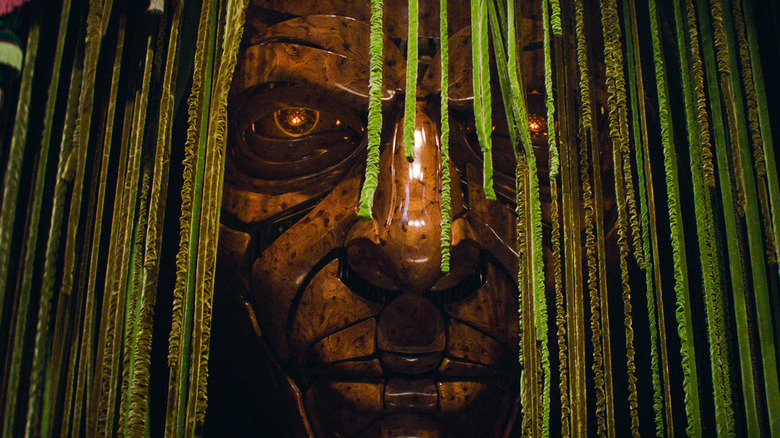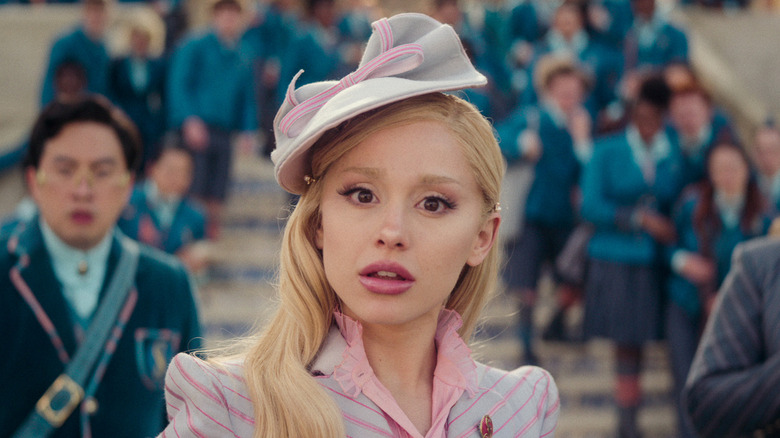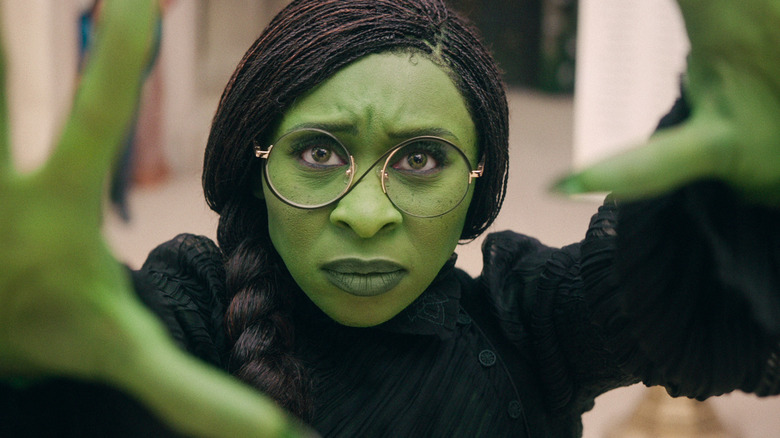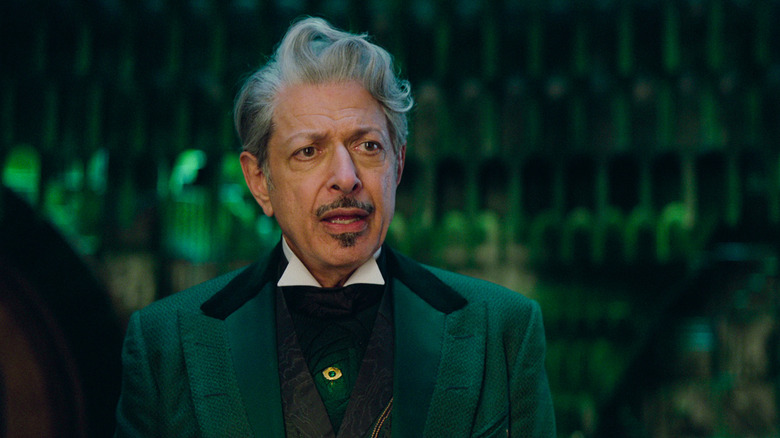All The Ways Wicked: Part One Connects To The Wizard Of Oz
Spoilers for "Wicked" follow.
Jon M. Chu's new musical fantasy "Wicked," which is officially called "Wicked: Part I," according to the title card, is based on the hit 2003 Broadway show that was, in turn, based in the 1995 novel by Gregory Maguire. The novel, in itself, was a reimagination of L. Frank Baum's 1900 kid-lit classic "The Wonderful Wizard of Oz," but Maguire took his book's primary inspiration from Victor Fleming's 1939 film "The Wizard of Oz," arguably the most famous movie of all time. In making an 85-year cycle from the screen, to the page, to the stage, and then back to the screen, "Wicked" retains a lot of the iconography and basic aesthetics of Fleming's film and repackages them for a modern sensibility.
Some of what audiences will see in "Wicked" will feel natural, as the look and feel of Oz has bled into the mass subconsciousness, unable to be moved. Other references are more specific, drawing from small moments of "The Wizard of Oz" for little in-jokes.
The premise of "Wicked" is that the Wicked Witch of the West was actually a gentle, oppressed soul, hated for her green skin, who was merely the victim of betrayal and propaganda. Her real name was Elphaba. Maguire's book restages the Wizard as an authoritarian dictator who had a political motive for making the Wicked Witch into Oz's "villain"; leaders must, he feels, assemble their constituents against a villain. Galinda, the Witch of the North, is reimagined as a catty ex-college roommate and friend of the Wicked Witch who had to betray her for personal reasons.
In Baum's original book, of course, the Wicked Witch of the West wasn't a green-skinned crone in a black cloak, but a pale-skinned punker with an eye patch and silver shoes. The Witch's natural green skin was taken from Fleming's movie. Below you'll find some of the ways that "Wicked" connects to "The Wizard of Oz."
The details between the book, the 1939 movie, and 'Wicked' only occasionally line up
Fleming, I should pause to note, was the only credited director on "The Wizard of Oz," and while he did do the bulk of directing, he left the film early to work on "Gone With the Wind." George Cukor made many creative directorial decisions on the movie before shooting began, and Fleming merely took over, leaving those decisions in place. After Fleming left, King Vidor took over and directed most of the Kansas scenes, including the "Somewhere Over the Rainbow" number. For clarity's sake, I'll continue to refer to the film as Fleming's.
The basic look of Fleming's film informed the pink-and-green color scheme seen throughout "Wicked." Elphaba (Cynthia Erivo) was made to look green, like Margaret Hamilton. Galinda, as she was played by Billie Burke, wore a large pink ballgown, so the Galinda of "Wicked" is now a pink-obsessed valley girl type. She's played by pop star Ariana Grande.
In Fleming's film, the Wicked Witch wears a pointed black hat, traditional for witches as they are presented in pop media. In the world of "Wicked," the black hat was a gift from Galinda to Elphaba. Galinda presented the hat as a potential accessory for an upcoming dance event, secretly hating that hat and wanting to prank Elphaba. Elphaba ends up embracing the hat, as it matches the rest of her black ensemble.
The Wicked Witch also wears a black cloak and rides a flying broomstick. Those two items in "Wicked" are hastily handed to Elphaba in the Emerald City after she and Galinda have run afoul of the Wizard (Jeff Goldblum). She uses her black magic to learn to fly and flees the Winkie guards. It seems she kept those accoutrements into the events of Fleming's film. The Winkie guards might better be known as the "Oh-Ee-Oh" soldiers outside the Witch's castle.
The Wizard of Oz first builds the Yellow Brick Road in 'Wicked'
One of the characters in "Wicked," a Prince Charming-type named Fiyero (Jonathan Bailey) describes himself as a Winkie, implying that he may become one of the Winkie guards. Fans of Maguire's book, however, will know that something much different is fated for the character. A fun reference: Fiyero enters the movie in a horse-drawn carriage, and the horse, while not closely seen, is clearly changing colors. This is a reference to the Horse of a Different Color seen in Fleming's film.
Speaking of the Wizard, in Fleming's film and in Baum's book, the man himself — actually a mild-mannered human from Omaha, Nebraska — used clever machines and special effects technology to appear threatening to visitors. In the book, he is a giant floating head to Dorothy, a goddess-like woman to the Scarecrow, a flaming ball of fire to the Cowardly Lion, and a fanged beast to the Tin Woodman. In Fleming's film, only the giant floating head was retained, while the human Wizard was played by Frank Morgan. In "Wicked," the Wizard (Jeff Goldblum) also retains the giant head, this time envisioned as a massive, practical puppet. The Wizard isn't so guarded about it, though. He emerges from behind his curtain after only a few moments of puppetry.
Late in the film, the Wizard reveals a new infrastructure plan for the Land of Oz: a brick road akin to the Roman Roads of ancient times. All roads would lead to the Emerald City, and would extend to every corner of the country. The Wizard has a model built, but construction hasn't begun yet. He just doesn't know what color the bricks ought to be. Maybe Galinda and Elphaba will have some input ...
And the connections to 'The Wizard of Oz' continue
One of the plot points of "Wicked" is the systematic suppression of talking animals. For reasons that won't be made clear until later in the film, the talking animals of Oz are being removed from positions of authority and forced to live in cages where they will never learn to speak. One of Elphaba's professors at Shiz University is a talking goat named Dr. Dillamond (Peter Dinklage) who will be apprehended by the local Ozzian police. The apprehension scene will feature a timid lion cub in a cage, used as an example of how animals can be tamed and made ... cowardly.
Elphaba will free the lion cub and release it into the woods. One might think that lion will grow up to be someone significant. Also fun: Elphaba flees with the cub in a bicycle basket, very much the same way Mrs. Gulch (Hamilton) kidnapped Toto in 1939.
In both Baum's book and in Fleming's movie, the Wicked Witch of the West has an army of blue-skinny flying monkeys to do her bidding. In "Wicked," we finally learn how those monkeys got their wings. It seems that the Wizard has a grimoire in his possession, called the Grimmerie. There's a spell in that book that can instantaneously cause simians to become avian. Will Elphaba read the spell? It seems likely.
Munchkinland is still on the outskirts of Oz, although it looks very different, and the Munchkins are no longer played by little person actors. Like in Fleming's film, however, there is a big celebration in Munchkinland when a Wicked Witch is killed. "Wicked" actually opens with the death of the Wicked Witch of the West, and audiences see the puddle she has been reduced to. This is, as we all know, a reference to Dorothy's melting her with a bucket of water. It's worth noting that since "Wicked" is just the first part of a two-part film series, there are bound to be more references when "Wicked Part 2" opens in theaters next year.
"Wicked: Part I" is now playing in theaters.



